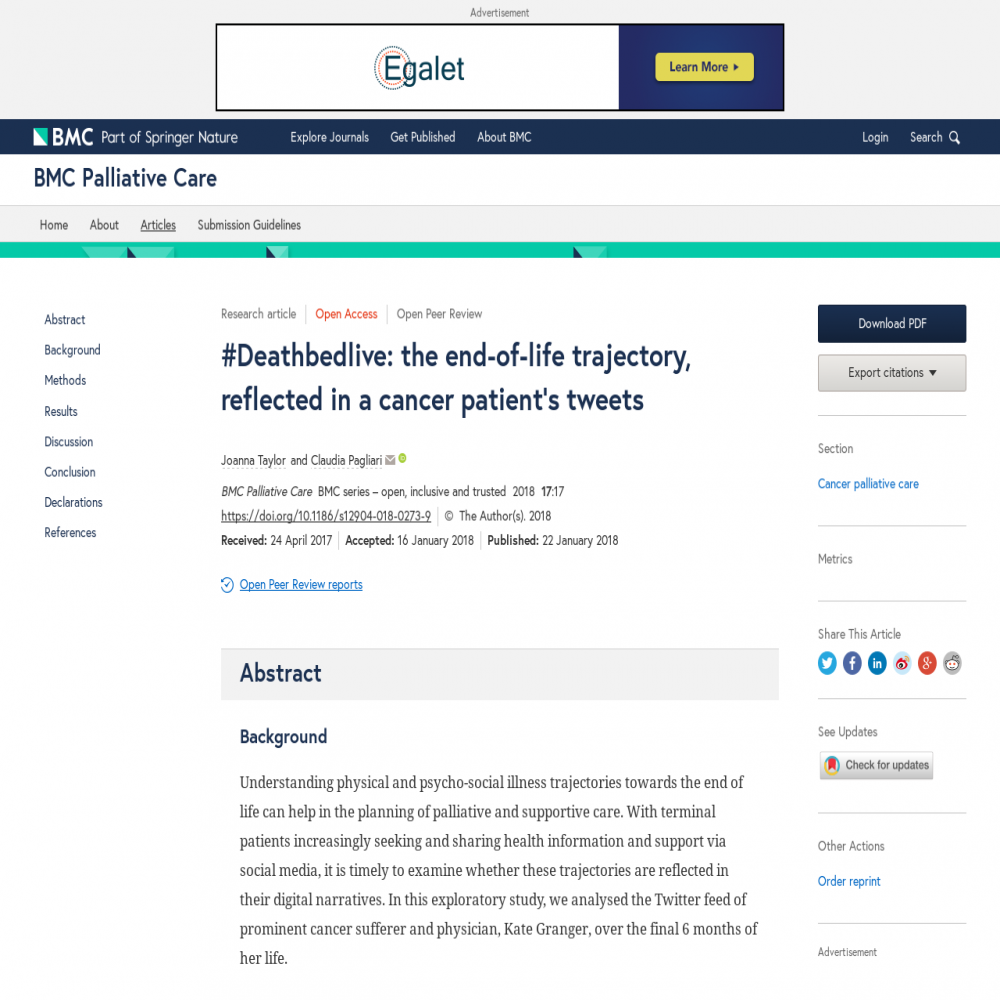#Deathbedlive: the end-of-life trajectory, reflected in a cancer patient’s tweets
A healthcare social media research article published in BMC Palliative Care, January 21, 2018
- Title
- #Deathbedlive: the end-of-life trajectory, reflected in a cancer patient’s tweets
- Authors (alpha)
- Claudia Pagliari, Joanna Taylor
- Published
- January 21, 2018
- Journal
- BMC Palliative Care
- Impact Factor
- 2.335
- DOI
- 10.1186/s12904-018-0273-9
- Pubmed
- 29357865
- Altmetric
Abstract
Understanding physical and psycho-social illness trajectories towards the end of life can help in the planning of palliative and supportive care. With terminal patients increasingly seeking and sharing health information and support via social media, it is timely to examine whether these trajectories are reflected in their digital narratives. In this exploratory study, we analysed the Twitter feed of prominent cancer sufferer and physician, Kate Granger, over the final 6 months of her life. With the consent of Kate's widower, Chris Pointon, 1628 Twitter posts from @GrangerKate were manually screened. The 550 tweets judged relevant to her disease were qualitatively content analysed with reference to the six modifiable dimensions of the patient experience in Emanuel and Emanuel's 'framework for a good death'. The frequency of each tweet category was charted over time and textual content was examined and cross-referenced with key events, to obtain a deeper understanding of its nature and significance. Tweets were associated with physical symptoms (N = 270), psychological and cognitive symptoms (N = 213), social relationships and support (N = 85), economic demands and care giving needs (N = 85), hopes and expectations (N = 51) and spiritual beliefs (N = 7). While medical treatments and procedures were discussed in detail, medical information-seeking was largely absent, likely reflecting Kate clinical expertise. Spirituality was expressed more as hope in treatments or "someone out there listening", than in religious terms. The high value of Kate's palliative care team was a dominant theme in the support category, alongside the support she received from her online community of fellow sufferers, friends, family and colleagues. Significant events, such as medical procedures and hospital stays generated the densest Twitter engagement. Transitions between trajectory phases were marked by changes in the relative frequency of tweet-types. In Kate's words, "the power of patient narrative cannot be underestimated". While this analysis spanned only 6 months, it yielded rich insights. The results reflect theorised end-of-life dimensions and reveal the potential of social media data and digital bio-ethnography to shine a light on terminal patients' lived experiences, coping strategies and support needs, suggesting new opportunities for enhancing personalised palliative care and avenues for further research.
Altmetric
The Altmetric Attention Score is based on the attention a research article gets on the internet. Each coloured thread in the circle represents a different type of online attention and the number in the centre is the Altmetric Attention Score. The score is calculated based on two main sources of online attention: social media and mainstream news media.
Healthcare Social Media Research
See the full list of healthcare social media research articles with data from or reference to Symplur.
#hcsmR is a collaboration between Stanford Medicine X and Symplur.


